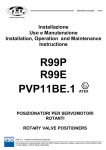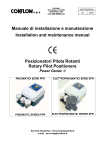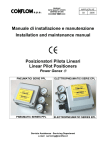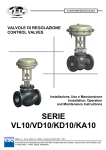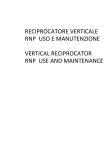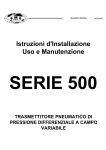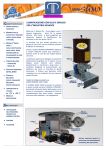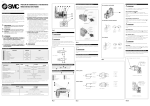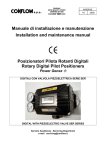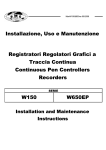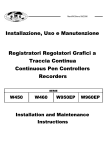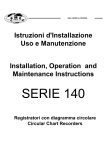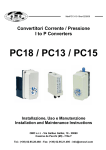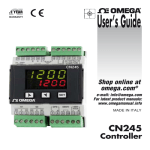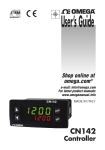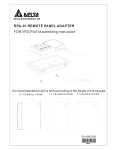Download Installazione Uso e Manutenzione Installation, Operation
Transcript
ManR01ne 07/2008 www.omcsrl.com Installazione Uso e Manutenzione Installation, Operation and Maintenance Instructions RP01 RE01 POSIZIONATORI PER VALVOLE DI REGOLAZIONE CONTROL VALVE POSITIONERS OMC s.r.l. Industrial Automation Equipment Our products are manufactured under ISO-9001 Quality Assurance System, approved by CSQ certified under nr.9190.OMC2 - FIRST ISSUE 1994/08/04 INDICE INDEX 1. DESCRIZIONE 1. DESCRIPTION 2. DATI TECNICI 2. TECHNICAL DATA 2.1 MATERIALI 2.1 MATERIALS 2.2 PORTATA ARIA RP01 E RE01 2.2 RP01 & PR01 AIR DELIVERY 2.3 PORTATA ARIA RP01HP E RE01HP 2.3 RP01HP & RE01HP AIR DELIVERY 2.4 CONSUMO D'ARIA RP01 E PR01 2.4 RP01 & PR01 AIR CONSUMPTION 2.5 DIMENSIONI DI INGOMBRO 2.5 DIMENSIONS 3. ACCOPPIAMENTO POSIZIONATORE - VALVOLA 3.1 FUNZIONAMENTO 3. POSITIONER - ACTUATOR COUPLING 3.1 OPERATION 3. INSTALLAZIONE 3. INSTALLATION 3.1 MONTAGGIO SU ATTUATORE CON CASTELLO A COLONNE (IEC 534) 3.1 FITTING THE POSITIONER TO PILLAR TYPE ACTUATOR (IEC 534) 3.2 MONTAGGIO SU ATTUATORE CON CASTELLO INTEGRALE (IEC 534) 3.2 FITTING THE POSITIONER TO YOKE TYPE ACTUATOR (IEC 534) 3.3 MONTAGGIO SU ALTRI TIPI DI ATTUATORE 3.3 AVAILABLE FIXING KITS 5. CONNESSIONI ELETTRICHE E PNEUMATICHE 5. AIR AND ELECTRICAL CONNECTIONS 6. MESSA IN FUNZIONE 6. COMMISSIONING 7. REGOLAZIONE VELOCITÀ VALVOLA 7. VALVE SPEED ADJUSTMENT 8. FUNZIONAMENTO IN SPLIT RANGE 8. SPLIT RANGE OPERATION 9. INVERSIONE DELL'AZIONE 9. ACTION REVERSAL 10. MANUTENZIONE 10. MAINTENANCE 11. MALFUNZIONAMENTO: SINTOMI, CAUSE E RIMEDI 11. TROUBLE CHART: SYMPTOMS, CAUSES AND ACTION TO TAKE 12. RICAMBI 12. SPARE PARTS 12.1 RE01 e RE01.1 12.1 RE01 & RE01.1 12.2 RP01 12.2 RP01 13. NOTE DI SICUREZZA 13. SAFETY NOTES 14. VERSIONE CON TRASMETTITORE DI POSIZIONE 14. POSITIONER WITH POSITION TRANSMITTER OMC s.r.l. - Via Galileo Galilei, 18 - 20060 Cassina de Pecchi (MI) - ITALY Tel.: (+39) 02.95.28.468 - Fax: (+39) 02.95.21.495 - [email protected] Pag.2 1. DESCRIZIONE 1. DESCRIPTION RP01, RE01 e RE01.1 sono posizionatori a semplice con segnale in entrata 3÷15 psi o 4÷20 mA per il controllo proporzionale di attuatori lineari. Gli apparecchi confrontano il segnale proveniente dall'unità regolante con la posizione della leva di feedback collegata all'attuatore. La comparazione tra queste due forze genera una pressione di uscita che agisce direttamente sulla membrana dell'attuatore. The single acting positioners RP01 RE01 and RE01.1 require an input signal of 3÷15 psi / 4÷20 mA for proportional control valves. The Positioner compares the output signal from a controller with the position feedback, and varies a pneumatic output signal to the actuator accordingly. The valve position is therefore guaranteed for any controller output signal and the effects of varying differential pressure, stem friction and diaphragm hysteresis are overcome. 2. DATI TECNICI 2. TECHNICAL DATA GRADO DI PROTEZIONE MONTAGGIO IEC 534 (NAMUR) da 3 a 7 mm con molla tipo 1 da 6 a 18 mm con molla tipo 2 da 9 a 33 mm con molla tipo 3 da 14 a 53 mm molla tipo 5 da 35 a 100 mm molla tipo 6 da 100 mm a infinito (*) CORSA NOMINALE CONNESSIONI PNEUMATICHE ARIA DI ALIMENTAZIONE USCITA RP01 ERRORE DI RIPETIBILITA' RE01 /.1 ERRORE DI ISTERESI PESO TEMPERATURA AMBIENTE RP01 RE01 /.1 RP01 RE01 /.1 RP01 RE01 /.1 TEMPERATURA STOCCAGGIO SEGNALE DI COMANDO IP55 IP65 (*) 1/4" NPT 2…10 bar 0....100 % della pressione di alimentazione < 0,1 % del campo < 0,2 % del campo < 0,6 % del campo < 1 % del campo ≅1,3 Kg ≅1,4 Kg -20....+80 °C -20....+70 °C -30....+80 °C RP01 RE01 /.1 CONNESSIONI ELETTRICHE (R01E / R01E.1) 3÷15 Psi (0,2÷1 bar) altri segnali (*) 4 ÷ 20 mA altri segnali (*) Pressacavo PG9 altre misure (*) ≤ 30 V Ui IP55 IP65 (*) PROTECTION CLASS MOUNTING IEC 534 (NAMUR) NOMINAL TRAVEL RANGE PNEUMATIC CONNECTIONS SUPPLY AIR PRESSURE OUTPUT RP01 REPEATIBILITY RE01 /.1 RP01 HYSTERESIS RE01 /.1 RP01 WEIGHT RE01 /.1 RP01P AMBIENT TEMPERTURE RE01 /.1 STORAGE TEMPERATURE from 3 to 7 mm (spring type 1) from 6 to 18 mm (spring type 2) from 9 to 33 mm (spring type 3) from 14 to 53 mm (spring type 5) from 35 to 100 mm (spring type 6) from 100 to >100 mm (*) 1/4" NPT 2…10 bar 0....100 % of the supply air pressure < 0,1 % of full range < 0.2 % of full range < 0,6 % of full range < 1 % of full range ≅1,3 Kg ≅1,4 Kg -20....+80 °C -20....+70 °C -30....+80 °C RP01 INPUT RE01 /.1 ELECTRIC CONNECTIONS (R01E / R01E.1) 3÷15 Psi (0,2÷1 bar) other input (*) 4 ÷ 20 mA other input(*) Cable gland PG9 other connections (*) ≤ 30 V Ui Ii ≤ 150 mA Ii ≤ 150 mA PI ≤ 0,80 W Pi ≤ 0,80 W Max 250 Ω Impedenza Max 250 Ω Impedance Ci ≈ 0 (trascurabile) Ci ≈ 0 (negligible) Li ≈ 0 (trascurabile) Li ≈ 0 (negligible) * su richiesta * on request 2.1 MATERIALI 2.1 MATERIALS CORPO COPERCHIO RP01 / RE01 RE01.1 CASSETTO DISTRIBUTORE MEMBRANA RICEVITORE In alluminio pressofuso verniciatura antiacido Policarbonato Alluminio Cassetto: Lega di Rame Perno: Acciaio INOX Gomma nitrilica BODY COVER RP01 / RE01 RE01.1 SLIDE VALVE RECEIVER DIAPHRAGM Die cast aluminium with anti corrosive paint Polycarbonate Aluminium Box: Copper Alloy Pivot: Stainless Steel Nitrile Rubber Pag. 3 2.2 PORTATA ARIA RP01 E RE01 2.2 RP01 & PR01 AIR DELIVERY Prova effettuata con tubo 6 x 8 mm Test effected with pipe 6 x 8 mm ALIMENTAZIONE 2 BAR regolabile da 1 a 10 Nm³/h 2 BAR SUPPLY adjustable from 1 to 10 Nm³/h ALIMENTAZIONE 4 BAR regolabile da 1 a 16 Nm³/h 4 BAR SUPPLY adjustable from 1 to 16 Nm³/h ALIMENTAZIONE 6 BAR regolabile da 1 a 22 Nm³/h 6 BAR SUPPLY adjustable from 1 to 22 Nm³/h ALIMENTAZIONE 8 BAR regolabile da 1 a 28 Nm³/h 8 BAR SUPPLY adjustable from 1 to 28 Nm³/h ALIMENTAZIONE 10 BAR regolabile da 1 a 34 Nm³/h 10 BAR SUPPLY adjustable from 1 to 34 Nm³/h 2.4 CONSUMO D'ARIA RP01 E RE01 2.4 RP01 & PR01 AIR CONSUMPTION Prova effettuata con tubo 4 x 6 mm Test effected with pipe 4 x 6 mm ALIMENTAZIONE 2 BAR max 0,2 Nm³/h 2 BAR SUPPLY max 0,2 Nm³/h ALIMENTAZIONE 3 BAR max 0,4 Nm³/h 3 BAR SUPPLY max 0,4 Nm³/h ALIMENTAZIONE 4 BAR max 0,5 Nm³/h 4 BAR SUPPLY max 0,5 Nm³/h ALIMENTAZIONE 5 BAR max 0,6 Nm³/h 5 BAR SUPPLY max 0,6 Nm³/h ALIMENTAZIONE 6 BAR max 0,7 Nm³/h 6 BAR SUPPLY max 0,7 Nm³/h ALIMENTAZIONE 7 BAR max 0,8 Nm³/h 7 BAR SUPPLY max 0,8 Nm³/h ALIMENTAZIONE 8 BAR max 1,0 Nm³/h 8 BAR SUPPLY max 1,0 Nm³/h ALIMENTAZIONE 10 BAR max 1,5 Nm³/h 10 BAR SUPPLY max 1,5 Nm³/h Portata - Air Delivery (Nm³/h) DIAGRAMMA CONSUMI - AIR CONSUMPTION DIAGRAM 1,6 1,4 1,2 1 0,8 0,6 0,4 0,2 0 2 3 4 5 6 7 8 9 10 Alimentazione - Supply (bar) 2.5 DIMENSIONI DI INGOMBRO 2.5 DIMENSIONS * con prolunga "PSN" su richiesta * with "PSN" adapter on request 181 (226)* 86 70 (115)* 112 180 142 Fig. 2.5 Pag. 4 3. ACCOPPIAMENTO POSIZIONATORE - VALVOLA 3. POSITIONER - ACTUATOR COUPLING 3.1 FUNZIONAMENTO 3.1 OPERATION I posizionatori vengono forniti per il funzionamento in azione diretta a semplice effetto. Qualora si voglia invertire l'azione è sufficiente togliere il tappo dall'uscita "A" (Fig.3 Pag.5) del posizionatore e chiudere l'uscita "OUT1". The positioner are normally supplied for single acting operations and direct action. In case the reverse action is required then remove the plug from "A " (Fig.3 Pag.5) and close the output "OUT1". ACCOPPIAMENTO POSIZIONATORE - VALVOLA POSITIONER - ACTUATOR COUPLING POSIZIONE LEVA DI FEEDBACK FEEDBACK LEVER POSITION Fig. 3.1.A 15 PSI / 20 mA 3 PSI / 4 mA OUT 1 OUT 1 Fig. 3.1.B 3 PSI / 4 mA 15 PSI / 20 mA AZIONE ACTION Posizionatore con azione diretta: il segnale in ingresso cresce, l'asta dell'otturatore si muove verso l'alto (molle compresse). Positioner with direct action: Input signal rises, plug stem goes up (actuator springs compressed) Posizionatore con azione diretta: il segnale in ingresso cresce, l'asta dell'otturatore si muove verso il basso (molle compresse). Positioner with direct action: Input signal rises, plug stem goes down (actuator springs compressed) Pag. 5 OPEN APRIRE A Fig. 3 OUT 1 ACCOPPIAMENTO POSIZIONATORE - VALVOLA POSITIONER - ACTUATOR COUPLING POSIZIONE LEVA DI FEEDBACK FEEDBACK LEVER POSITION CLOSED CHIUDERE AZIONE ACTION Posizionatore con azione inversa: il segnale in ingresso cresce, l'asta dell'attuatore si muove verso il basso (molle decompresse). Fig. 3.1.C 3 PSI / 4 mA Positioner with reverse action: Input signal rises, plug stem goes down (actuator springs decompressed) 15 PSI / 20 mA Fig. 3.1.D 15 PSI / 20 mA 3 PSI / 4 mA Posizionatore con azione inversa: il segnale in ingresso cresce, l'asta dell'attuatore si muove verso l'alto (molle decompresse). Positioner with reverse action: Input signal rises, plug stem goes up (actuator springs decompressed) Pag. 6 4. INSTALLAZIONE 4. INSTALLATION 4.1 MONTAGGIO SU ATTUATORE CON CATSTELLO 4.1 FITTING THE POSITIONER TO PILLAR TYPE 1. Per il corretto orientamento del posizionatore controllare la Fig. 4.1 N.B.: Le istruzioni che seguono si riferiscono alle condizioni rappresentate nelle Fig. 3.1.A, 3.1.D, 3.2.A e 3.2.A 2. Montare la staffa di fissaggio in posizione centrale sul castello dell'attuatore, fissandola con i 4 dadi in dotazione come in Fig. 4.1 3. Fissare il posizionatore sulla staffa utilizzando la vite in dotazione. 4. Alloggiare il perno di feedback come in Fig. 3.3 1. Check Fig. 4.1 for correct orientation of positioner. Note: The following instructions assume that the positioner is to be fitted as Fig. 3.1.A, 3.1.D, 3.2.A e 3.2.A 2. Place the two halves of the mounting bracket either side of the pillar and hand tighten the 4 bolts. Slide the bracket to halfway up the pillar. 3. Mount the feedback lever bracket (Fig. 3.3) 4.2 MONTAGGIO SU ATTUATORE CON CASTELLO INTEGRALE (IEC 534) 4.2 FITTING THE POSITIONER TO YOKE TYPE ACTUATORS (IEC 534) 1. Per il corretto orientamento del posizionatore controllare la Fig. 4.2 N.B.: Le istruzioni che seguono si riferiscono alle condizioni rappresentate nelle Fig. 3.1.A, 3.1.D, 3.2.A e 3.2.A 2. Montare il posizionatore direttamente sul castello dell'attuatore utilizzando la vite in dotazione. 3. Alloggiare la leva di feedback come in Fig. 3.3 1. Check Fig. 4.2 for correct orientation of positioner. Note: The following instructions assume that the positioner is to be fitted as Fig. 3.1.A, 3.1.D, 3.2.A e 3.2.A 2. For yoke type actuators the positioner fits directly to the yoke via a central bolt. Using the longer of the two bolts supplied, locate the positioner and tighten. 3. Mount the feedback lever bracket (Fig. 3.3) Fig. 4.1 Fig. 4.2 4.3 MONTAGGIO SU ALTRI TIPI DI ATTUATORE 4.3 AVAILABLE FIXING KITS Sono disponibili diversi tipi di staffe che consentono il Different solution of fittings are also available to mount the fissaggio del posizionatore su qualsiasi tipo di valvola come positioner to any type of valve actuator. See Fig. 4.3.1, 4.3.2 illustrato nelle Fig. 4.3.1, 4.3.2 e 4.3.3 and 4.3.3. Fig. 4.3.1 Fixing kit 072-55 Kit di fissaggio 072-55 Fig. 4.3.2 Fixing kit 973SUP Kit di fissaggio 973SUP Fig. 4.3.3 Valve spindle adaptor 180-23 Adattatore perno di feedback 180-23 Pag. 7 5. CONNESSIONI PNEUMATICHE E ELETTRICHE 5. AIR AND ELECTRICAL CONNECTIONS Tutti i collegamenti pneumatici sono facilmente accessibili (Fig. 5). Per le connessioni elettriche (solo RE01 e RE01.1) inserire i due fili nel passacavo e collegarli alla morsettiera interna contrassegnata con "+" e "-" (Fig. 5.1). Per assicurare il corretto funzionamento del Posizionatore, l'aria di alimentazione deve essere libera da ogni impurità quali polveri, ecc. utilizzando un filtro riduttore installato in linea. All pneumatic connections are easily accessible externally (see Fig. 5). Connect two wires to the terminal board "+" and "-" (RE01 only) (see Fig.5.1). To ensure trouble free use of this positioner, the air supply should be conditioned to remove dirt and moisture. A filter regulator should be fitted upstream of the device. Electrical connections are made by moving the lid. ATTENZIONE! CAUTION! I posizionatori modello RE01.1 (sicurezza intrinseca) devono essere alimentati da costruzioni elettriche associate certificate in conformità alle norme 60079 che rispettino i limiti delle caratteristiche elettriche indicate nel paragrafo 2. OUTPUT 1 The positioners type RE01.1 (intrinsic safety) must be feed by electric devices certificated in conformity with EN 60079 standards. The devices must comply the electric features mentioned on technical specification (see chapter 2). Fig. 5 SEGNALE DI COMANDO (RE01) INPUT SIGNAL (RE01 / RE01.1) SUPPLY / ALIMENTAZIONE SEGNALE DI COMANDO 3 ÷ 15 PSI (RP01) 3 ÷ 15 PSI INPUT SIGNAL (RP01) Fig. 5.1 INPUT SIGNAL (RE01 / RE01.1) 4÷20mA IN 6. MESSA IN FUNZIONE 6. COMMISSIONING 1. Controllare che tutti i collegamenti siano corretti e che il posizionatore sia montato secondo la funzione richiesta (vedi sezione 3). 2. Inviare un segnale di 4mA (o 3psi) e agire sulla vite di zero (Fig. 6.1) sino far partire la valvola. A questo punto girare la vite molto lentamente in senso contrario riportando l'asta dell'otturatore in posizione di riposo. Controllare l'indicatore di corsa dell'attuatore. 1. Check that all pneumatic and electrical connections are correct and that the positioner is mounted according to the function you require. Refer to section 3. 2. Inject a signal of 4 mA (or 3psi) and adjust the start screw as per fig. 6.1 such that the position of the valve is at the fully extended position. At this point the valve plug should just be touching its seat and any counter rotation of the start screw causes the valve to retract. Set the valve position indicator. Pag. 8 3. Inviare un segnale di 20mA (o 15psi) e controllare che l'asta dell'otturatore compia la corsa desiderata. In caso contrario agire sul perno scorrevole (vedi Fig. 6.2). Controllare l'indicatore di corsa dell'attuatore. 4. E' possibile che nell'esecuzione dell'operazione "3" si verifichi uno spostamento del punto zero. Se questo accade è sufficente ripetere le operazioni "2" e "3" per ristabilire le condizioni volute. 5. Con un segnale di 20mA (o 15psi) controllare che la corsa compiuta dalla valvola corrisponda a quella indicata sull'etichetta della valvola stessa. 6. Come controllo finale, inviare un segnale di 12 mA (o 9psi) e verificare che l'asta dell'otturatore della valvola compia il 50% della corsa. 7. Quando il posizionatore è in funzione è possibile regolare la portata (vedi Capitolo 7), modificando così la velocità di intervento dell'attuatore. 3. Inject a signal of 20 mA (or 15psi)and slide the feedback lever pin such that the valve is in the fully retracted position (moving the pin towards the end of the lever increases the movement see fig. 6.2). Set the valve position indicator. 4. Adjustment of the feedback pin will effect slightly the adjustment of the start screw so steps 2 and 3 will need to be repeated. 5. With a signal of 20 mA (or 15psi), check that the distance from the lower valve po<sition indicator and the travel indicator corresponds to the travel marked on the label of the valve. 6. As a final check ensure that the valve moves to 50% open with a signal of 12 mA (or 9psi). CORREZIONE CORSA SPAN ADJUSTMENT Fig. 6.1 Fig. 6.2 CORREZIONE ZERO ZERO ADJUSTMENT 7. REGOLAZIONE VELOCITÀ VALVOLA 7. VALVE SPEED ADJUSTMENT Con i posizionatori RP01 e RE01 è possibile regolare le velocità di apertura e chiusura della valvola. Per regolare la velocità dell'attuatore agire sulla vite "B" (fig.7) A splitted opening / closing speed adjustment of the valve should be made on RP01 and RE01. To control the actuator speed: operate on screws "B" (see fig. 7). Fig. 7 B Pag. 9 8. FUNZIONAMENTO IN SPLIT RANGE 8. SPLIT RANGE OPERATION Parecchie applicazioni richiedono che la valvola esegua il 100% della corsa con il segnale in ingresso ridotto del 50% (3÷9psi o 9÷15psi per RP01 ; 4÷12mA o 12÷20mA per RE01 e RE01.1). Nel caso sia richiesta questa operazione è sufficiente correggere la corsa, come descritto nel capitolo 6. Many applications require the 100% of valve stroke with a 50% reduced input signal (3÷9 psi or 9÷15 psi for RP01; 4÷12mA or 12÷20mA for RE01 & RE01.1). In case this application is required then the stroke span must be adjusted as described on item 6. 9. INVERSIONE DELL'AZIONE 9. ACTION REVERSAL I posizionatori vengono forniti per il funzionamento in azione Positioners are provided to operate on a single acting diretta a semplice effetto. Per invertire l'azione è sufficiente actuator with direct action mode. To reverse the action see seguire le indicazioni del capitolo 3. the description on item 3. 9. INVERSIONE DELL'AZIONE 9. ACTION REVERSAL I posizionatori vengono forniti per il funzionamento in azione Positioners are provided to operate on a single acting diretta a semplice effetto. Per invertire l'azione è sufficiente actuator with direct action mode. To reverse the action see seguire le indicazioni del capitolo 3. the description on item 3. 10. MANUTENZIONE (solo RE01 e RE01.1) 10. MAINTENANCE (only RE01 and RE01.1) Le impurità contenute nell'aria di alimentazione (olii, polveri, acqua, ecc...), sono la principale causa delle anomalie di funzionamento del posizionatore. Esse si depositano all'interno del posizionatore stesso ostruendone le parti vitali. L'utilizzo di un filtro sull'aria di alimentazione diminuisce, ma non vieta, il formarsi di depositi. Periodicamente occorre quindi rimuovere le eventuali impurità come segue: 1) Chiudere l'alimentazione al posizionatore. 2) Svitare la vite "A" (vedi Fig.8) 3) Estrarre il particolare "B" 4) Pulire il foro calibrato con c'apposito pulitore "C" posto all'interno del coperchio The incoming air impurities (oil, dust, water etc..) are the main cause of positioner failures. These impurities seep into the internal parts of the equipment which get occluded consequently. The use of an air filter upstream reduces the internal sediments but it does not exclude them completely. To avoid any failure caused by the impurities then clean periodically the nozzle as follow: 1) Stop the air feed 2) Unloose the screw "A" (see fig.8) 3) Pull out the nozzle plate "B" 4) Clean the calibrated orifice with the nozzle cleaner "C" which is located on the positioner cover The frequency of such cleaning operation depends on the La periodicità di tali operazioni dipende dalla qualità dell'aria air feed quality. di alimentazione. Fig. 8 B A C Pag. 10 11. MALFUNZIONAMENTO: SINTOMI, CAUSE E RIMEDI 11. TROUBLE: SYMPTOMS, CAUSES AND ACTION TO TAKE ATTENZIONE! CAUTION! Prima di compiere questa manovra, assicurarsi che il posizionatore non sia alimentato. Before be over this operate, make sure that the positioner has not in pressure. Prima di mettere mano allo strumento, verificare quanto Before operating the unit, please check: segue: - the unit proper supply - corretta alimentazione dello strumento - the pneumatic and process connections - collegamenti pneumatici e di processo - the good operating conditions and status of the valve - buon funzionamento e stato della valvola SINTOMO CAUSA RIMEDIO SYMPTOM CAUSE Velocità di apertura e L'attuatore pendola e Diminuire la velocità. chiusura della valvola non si stabilizza. Vedi capitolo 7 elevata. Actuator hunting Opening/Closing Reduce the speed. See valve speed too high chapter 7 Velocità di apertura e L'attuatore si muove Aumentare la velocità. chiusura della valvola molto lentamente. Vedi capitolo 7 bassa. Actuator motion is too slow. Opening/Closing valve speed too low Increase the speed. See chapter 7 Strozzatura ostruita Correggere. da depositi di impurità Vedi capitolo 10 The orifice is obstruct from impurity Reverse its position See chapter 10 Connessioni pneumatiche tra posizionatore e attuatore invertite Pneumatic connection between Reverse its position actuator and See chapter 3 positioner has been inverted Correggere. Vedi capitolo 3 Il posizionatore non Coordinamento tra Correggere. regola correttamente attuatore e Vedi capitolo 3 apertura e chiusura posizionatore errato. dell'attuatore. ACTION TO TAKE Actuator and Adjust. positioner coupling is Positioner with See chapter 3 wrong control action not correct Collegamenti elettrici Correggere. invertiti. (RE01 e Vedi capitolo 5 RE01.1) Electric connections has been inverted (RE01& RE01.1 only) Adjust. See chapter 5 Mancanza del Controllare e correggere segnale di comando Control signal missing Check and adjust Mancanza aria di alimentazione Supply air missing Check and adjust Controllare e correggere Velocità di apertura e L'attuatore si muove Diminuire la velocità. chiusura della valvola troppo velocemente. Vedi capitolo 7 elevata. Actuator motion is too high. Opening/Closing Reduce the speed. See valve speed too high chapter 7 L'attuatore non compie il campo desiderato Correggere. Vedi capitolo 6 Actuator span inadequate Span adjustment is wrong Adjust. See chapter 6 Correggere. Vedi capitolo 6 Actuator start point shifted Zero adjustment missing Adjust. See chapter 6 Regolazione di campo errata L'attuatore non parte Regolazione di zero dalla posizione errata desiderata Pag. 11 12. RICAMBI 12. SPARE PARTS 12.1 RE01 e RE01.1 12.1 RE01 and RE01.1 072-46 200-25 MOLLA SPRING 200-32 988SRE 200-30 180-20 180-12 988DLE 110-145 110-164 R01E R01E.1 180-19 972GMZ 180-22 180-21 200-31 200-44 073-105 073-106 RE01.1 RE01.1 RE01 RE01 INPUT mA INPUT Volt INPUT mA INPUT Volt Pag. 12 12.2 RP01 12.2 RP01 072-46 200-25 MOLLA SPRING 988SRP 200-30 180-20 180-12 988DLP 180-19 972GMZ 180-22 180-21 13. NOTE DI SICUREZZA (SOLO RE01.1) 13. SAFETY NOTES (ONLY RE01.1) ATTENZIONE! CAUTION! I posizionatori modello RE01.1 (sicurezza intrinseca) devono essere alimentati da costruzioni elettriche associate certificate in conformità alle norme EN 60079 che rispettino i limiti delle caratteristiche elettriche indicate nel paragrafo 2. The positioners type RE01.1 (intrinsic safety) must be feed by electric devices certificated in conformity with EN 60079 standards. The devices must comply the electric features mentioned on technical specification (see chapter 2). Pag. 13 14. VERSIONE CON TRASMETTITORE DI POSIZIONE 14. POSITIONER WITH POSITION TRANSMITTER Per la messa in funzione del trasmettitore di posizione seguire la seguente procedura: 1) Eseguire i collegamenti come in Fig. 5. 2) Portare la valvola in condizione di riposo 3) Agire sulla leva "A" portando il segnale di ritrasmissione a 4 mA. 4) Far compiere alla valvola la corsa desiderata. 5) Verificare che il trasmettitore di posizione invii un segnale di 20 mA. In caso contrario agire sul trimmer "C". 6) E' possibile che nell'esecuzione dell'operazione "4" si verifichi uno spostamento del punto zero. Se questo accade è sufficente ripetere l'operazione "4" agendo unicamente sul trimmer "B". Start the position transmitter as follows: 1) Perform the connections as shown in Fig. 5. 2) Put the valve in non-working position. 3) Check that the position transmitter emits a 4mA signal. If the signal is superior to 4mA use the lever "A", if it is inferior to 1mA use the trimmer "C" to eliminate the difference. 4) Let the valve perform the stroke required. 5) Check that the position transmitter emits a 20mA signal. If it does not, use the trimmer "C". 6) When performing the procedure at par.4, a zero shift may occur. In this case, simply repeat the procedure at par.4 by only using the trimmer "B". Segnale di comando 24 V c.c. IN LOAD Segnale di ritrasmissione 1 2 3 4 5 B C A B = Zero C = Campo B = Zero adjustment C = Span adjustment Pag. 14














